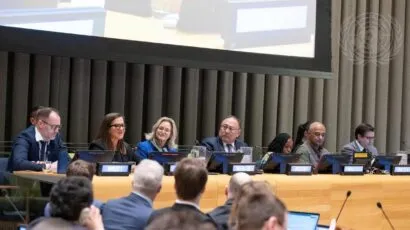Nuclear liability: The market-based, post-Fukushima case for ending Price-Anderson
By Mark Cooper | October 5, 2011
The need to revisit and revise regulations regarding financial responsibility for nuclear accidents has been clear and compelling for at least a quarter of a century (since Chernobyl) and has been made overwhelmingly obvious by Fukushima. The political opening to revise these regulations will vary from nation to nation, but is particularly small in the United States.
The Price-Anderson Act, which limits utility liability in the event of nuclear accidents, is totally out of sync with US energy goals because it places a heavy thumb on the scale of resource acquisition, favoring the wrong type of assets (high risk, high cost) in the current economic environment. In an uncertain environment, financial risk analysis teaches that the investor should preserve options and value flexibility by keeping decisions small and preferring investments with low, more predictable risks and short lead times. With their high risks, large sunk costs, long lead times, and extremely long asset lives, nuclear reactors are the worst type of assets to acquire at present.
With lower liability limits and more obstacles to relief for victims, international liability agreements are even more out of touch with reality than Price-Anderson. Indeed, the international liability regime is barely a regime at all, made up of six different treaties, only three of which have been ratified by enough nations to go into force (even though as few as five nations are needed). One quarter of the nuclear nations are not party to any of the agreements, and only half are parties to any single agreement. Four-fifths of the non-nuclear nations are not parties to any agreement. The United States is not a party to any of the treaties in force.
The market would be the best regime for dealing with compensation for nuclear plants, and private liability is the best regulator of market conduct. The current liability regime should be phased out by eliminating the cap on liability for new reactors, nationally and internationally. This treats existing licensed reactors “fairly” by not changing the rules of the game during the term of the license, but requires the operators of all nuclear reactors licensed in the future to bear full liability.
Any proposed change to Price-Anderson will draw aggressive opposition from the extremely well-funded nuclear lobby. But the costs of Fukushima to Japan’s government — estimated at hundreds of billions of dollars — do offer some level of political cover for members of Congress who are genuinely interested in improving the US government’s long-term financial prospects. Fukushima reminds decision makers that risk is real, shifting it between parties does not eliminate it, and the potential liability of nuclear accidents is huge. The current constellation of key events — post-accident evaluations, deficit debates, and pending expirations of liability limits — can foster left-right alliances in support of market discipline, creating the glimmer of hope that this moment is a unique opportunity for change.
The cost of nuclear accidents. Fifty years ago, as the commercial nuclear industry was starting up in the United States, two of the largest vendors of nuclear reactors made it clear that they would not build any reactors if they were not shielded from the liability of a nuclear accident. As energy-law scholar Joseph P. Tomain noted in his 1987 book, Nuclear Power Transformation, General Electric said it would not proceed “with a cloud of bankruptcy hanging over its head,” and a Westinghouse executive said, “We knew at the time that all questions (about safety risks) weren’t answered. That’s why we fully supported the Price-Anderson liability legislation. When I testified before Congress, I made it perfectly clear that we could not proceed as a private company without that kind of government backing.”
The rationale was clear: Because the risks of nuclear reactors appeared to be uninsurable in the marketplace, Congress enacted a limit on liability as a form of “infant industry” protection to help the commercial nuclear sector get going. Recent analyses support the conclusion that nuclear reactors continue to be virtually uninsurable. Congress socialized the cost of nuclear accidents with the Price-Anderson Act. Today utilities are required to carry a small amount of private insurance and create an industry-wide pool of about $12 billion for accident relief.
Although $12 billion may sound like a lot of money, it comes nowhere near covering the cost of a severe accident. The cost of the Fukushima accident has been estimated as high as $250 billion and will likely continue to increase. Tokyo Electric Power Co., the fourth largest utility in the world, was essentially bankrupted instantaneously by the accident. The cost of Chernobyl thus far is well over $600 billion with inflation taken into account, according to estimates by the Chernobyl Forum and Friends of the Earth Europe. The last significant assessment of the potential cost of major accidents in the United States was made soon after Three Mile Island.
Adjusting the estimate from that study for inflation, population growth and increase in property value would put the average cost of a severe accident above $400 billion, more than 30 times the limit on private liability, with an accident at the reactors closest to the largest population centers running as high as $1.5 trillion. Indian Point 3, located just north of New York City, would be the site of the most costly accident.
Moral hazards and unfunded mandates. When governments socialize risk — shift it from the private sector to the public — they create what economists call moral hazard. This is the hazard that the private actor, who no longer bears the risk, will do more risky things than he would have done, if he had borne the full liability of his actions. It is a moral problem; the irresponsible actions of one person or entity harm an innocent bystander. It is also an economic problem because it induces firms to engage in uneconomic activities.
In contemporary political terms, moral hazard creates a type of unfunded mandate. If an accident happens, the public will be asked to bear the burden that exceeds the liability limit — either in the form of increased public spending, or in the form of the uncompensated harms that the victims are forced to bear.
Seen in this way, private liability is a market-based regulator of economic conduct that, in the case of nuclear reactors, has been blocked by a political act of the government. When the government short-circuits private regulation, it frequently imposes public regulation. The Nuclear Regulatory Commission (NRC) is supposed to replace the invisible hand of private liability in the marketplace with the visible hand of public safety regulation. A recent report of a task force formed by the NRC to examine its safety regulations, however, reached the troubling conclusion that the existing system of public regulation is a “patchwork” with serious “gaps” that needed an overarching framework.
Political response to political action. Liability caps are political decisions. No one should be surprised to find that the reaction to Fukushima is political. Nor should it be surprising to find that the reaction is all over the map in democratic, capitalist nations with significant reliance on nuclear power.
The nuclear power industry exists only because governments agreed to take on the risk of accidents. One legitimate reaction to this uneconomic state of affairs would be to shut the industry down, or dramatically scale back reliance on nuclear power. In theory, reducing the number of reactors lowers the risk of accidents, and reducing the number to zero eliminates the risk.
In the United States, the approach for liability reform best supported by economic theory and practice would allow the marketplace to decide, after liability limits are removed. Any firm attempting to build a new nuclear plant would then be forced to confront the real risk of nuclear accidents, which means it would be forced to spend enough on safety to reduce the risk to the level that made the reactors insurable — if such a risk level is achievable.
Repealing the Price-Anderson Act for new reactors would be consistent with the original intent of the law, which was limited to 10 years’ duration in the belief that, as a 1957 Senate report notes, “the problem of reactor safety will be to a greater extent solved, and the insurance people will have had an experience on which to base a sound program of their own.” As the expiration of the act approached in 1967, it was clear that “private liability had not increased by even one dollar” and the act was extended. With the most recent license extensions in the United States, the nuclear “infant” will be 60 years old before it shoulders the full responsibility for accidents.
There is another option — having the NRC impose the rules, standards and fines that would protect the public in the way that full marketplace liability would. This option does not look very promising. More than 30 years ago, the NRC’s Lessons Learned Task Force, formed to investigate the accident at Three Mile Island, concluded that the commission’s approach to regulation had resulted in a “quiltwork” in need of “an articulate and widely noticed national nuclear safety policy with which to bind together the narrow and highly technical licensing requirements.” Just this past August, the task force the NRC formed to investigate the implications of Fukushima for US safety regulation concluded that the US system was a “patchwork” with important gaps and recommended reform to make the overall regulatory scheme “logical, systematic, coherent, clear and consistent.”
The international liability regime. From the international perspective, a move to restore market discipline would be the vastly preferable option for dealing with the nuclear liability problem. There are two basic instruments — the International Atomic Energy Administration Vienna Convention on Civil Liability for Nuclear Damage of 1963 (in force, 1977) and the Organisation for Economic Co-operation and Development’s Paris Convention on Third Party Liability in the Field of Nuclear Energy of 1960 (in force, 1968). The conventions share certain basic principles. They set very low limits on liability that are exclusive to the operator of the reactor (not suppliers) and provide minimal compensation for damage to property, health, and loss of life, and none for environmental damage or economic loss.
They differ on key issues, including the amount of liability. Because so few nations are party to the treaties, national liability regimes vary widely across the globe. The international conventions place a limit on liability of about $500 million; the average liability limit outside of the United States is less than $1 billion, with some nuclear nations as low as $100 million. Recent efforts that seek to raise the minimum liability to $2 billion, to include environmental harm and economic loss as compensable damages, and to allow states to hold operators fully liable for all loses have garnered ratifications from just two countries.
The experience of Fukushima shows how inadequate the international liability regime is. Operators in Japan, which is not a party to any of the international agreements, were required, according to the World Nuclear Association, “to provide a financial security amount of 120 billion Japanese yen ($1.4 billion).” Within weeks of the accident, the government moved to create a state-backed pool to insure the industry with contributions from operators of nuclear reactors and the government. The government committed to an initial share of $62 billion. Thus, the $2 billion figure that the international liability regime is limping toward would have been blown away by any Fukushima-like accident.
The international community is certainly not likely to reach consensus on a shutdown of the nuclear industry any time soon. On the one hand, from the point of view of getting a global standard of regulation, moral hazard is a particularly severe problem. When individual nations with nuclear power plants can shift the risk from their own people to other nations — as happened with the Chernobyl accident, which inflicted hundreds of billions of dollars in damage outside the Ukraine — they have a particularly strong incentive to do so, since they are not allocating burdens between their domestic constituencies. On the other hand, since the vast majority of nations in the world are not nuclear, they should have an interest in making the nuclear nations internalize the risks of nuclear reactors with a market-based liability approach.
Fukushima occurred 59 years after the first commercial nuclear accident (as defined by the International Nuclear Event Scale), and it is the 12th such event. Even if one believes that only the most severe accidents (Chernobyl and Fukushima) matter, two in 60 years is a lot, given the catastrophic impact. While it is folly to think that any liability regime will eliminate accidents, it is time — in terms of policy and politics — to give the market a chance to do what regulation has failed to accomplish.
Together, we make the world safer.
The Bulletin elevates expert voices above the noise. But as an independent nonprofit organization, our operations depend on the support of readers like you. Help us continue to deliver quality journalism that holds leaders accountable. Your support of our work at any level is important. In return, we promise our coverage will be understandable, influential, vigilant, solution-oriented, and fair-minded. Together we can make a difference.
Topics: Nuclear Energy, Opinion















